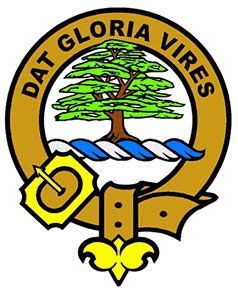Hog Clan
Hog Clan Crest: An oak tree, Proper.
Hog Clan Motto: Dat Gloria Vires (A good name gives strength).
Hog Clan History: There is some evidence to suggest that this surname first originated as a nickname, but it is nonetheless of considerable antiquity and various early documents in Scotland carry the name.
Around the year 1240, Turkil Hog, a serf, was sold, along with his sons and daughters, for three merks of silver, to the Benedictine Monks of Coldingham Priory, Berwickshire. Adam, a son of Henry del Hoga appears as a bondsman to the Abbey of Kelso in 1280.
Henry Hogg of Roxburghshire and John Hogg, burgess of Edinburgh, were signatories of the Ragman Roll of 1296 and in 1330, Roger Hog appears as a burgess of Edinburgh. This Roger Hog acquired land charters in the vicinity of Edinburgh during the reign of David I and in 1373, his family acquired Sydserf in East Lothian where the family remained for several generations. In 1379 the English garrison at Berwick Castle was taken by Hog, Lydzetwod, and their compatriots.
The Rev. Thomas Hogg, Scottish Presbyterian minister of Kiltearn, Ross-shire, was an eminent Highland covenanter who suffered much hardship for his cause. He was removed from his Church in 1662 and imprisoned in Scotland on numerous occasions, from 1668, in Forres, to the brutal State Prison on the Bass Rock, between the years 1677 to 1679. In 1684 Hogg was banished from Scotland altogether, and after a period of imprisonment in London, made his way to Holland, where William III Prince of Orange, made him a Royal Chaplain. He was restored to his parish church at Kiltearn in 1691, as he had predicted at the time when he was deposed, some thirty years before.
Roger Hog of Newliston, Linlithgow, was described in the certificate, of 1783, from the Lyon Office of Scotland, of the matriculation of his arms, heir male and representative of the ancient families of Hog of Harcarse and Bogend, and chief of the surname.
The most well-known of this name in Scotland is James Hogg (sometimes known as the Ettrick Shepherd), friend of Sir Walter Scott, and the author of The Private Memoirs and Confessions of a Justified Sinner.
Associated family names: Hogg, Hogge, Hogue.
Surname distribution in Scotland: The Hog/Hogg surname is most prevalent in Edinburgh City and the Lothians, Dumfriesshire and The Scottish Borders.
Places of Interest:
Newliston, by Kirkliston, nr Edinburgh. Imposing classical mansion built in 1759 for the Hog family, by leading Scottish architect, Robert Adam. The present house sits on the site of a much
earlier fortified tower house. The mansion and gardens, still owned by descendants of the Hog family, are only open to visitors for a month during summer.
The Ha’ Hoose, Raemoir, nr Banchory, Aberdeenshire. T-plan Lairds House, created for the Hogg family, c.1715, now an annex of the award winning Raemoir House Hotel.
Etrick Parish Church, Ettrick, Selkirkshire. James Hogg is buried here.
The James Hogg Monument, designed in 1860 by Andrew Currie, overlooks St Mary's Loch.
Tibbie Shiels Inn, St Mary's Loch, Selkirk. Celebrated meeting place of writers and poets, including James Hogg, who was a regular, and Sir Walter Scott.

